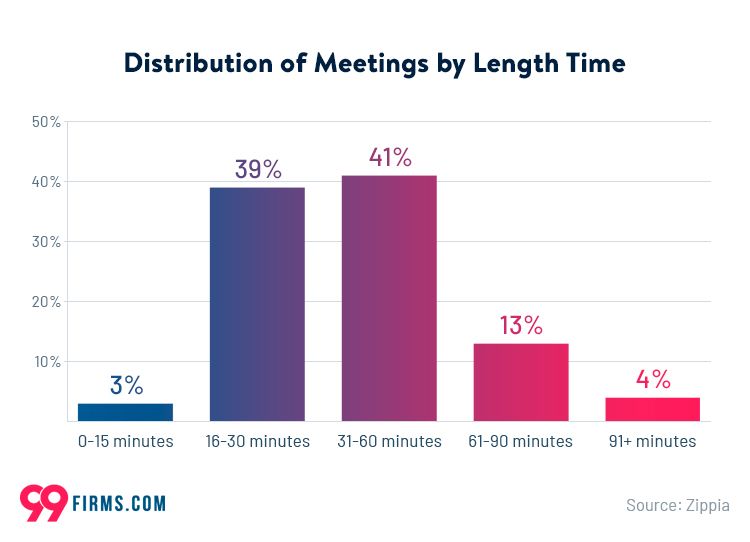Engaging meetings are hard to come by. Whether it’s battling against doggy technology, bad connections, or unfamiliar environments, a lot can get in the way. In order to host effective meetings, you need to involve all of your meeting participants. Without clear and easy communication, your meetings will struggle to get off the ground.
According to the Union of International Associations’ International Meetings Statistics 2022 Report, meeting productivity, and workplace engagement are closely linked. For 55% of employees, productive meetings contribute toward higher job satisfaction. Job satisfaction and overall productivity are closely linked, with high engagement leading to high levels of workplace achievements.
With that considered, the strategies that your businesses use for creating effective meetings will also impact overall workplace productivity. If you nail the meetings, your whole business will benefit. Without further ado, here are our top strategies for boosting engagement and interaction in office meetings.
Icebreakers and Energizers
Meeting icebreakers are typically one of the go-to ways that corporate culture tries to increase meeting participation. While many people are a little tired of this format, it is an undeniably useful strategy for teams that don’t yet know each other well.
Icebreakers are general questions that are easy to formulate a response to. These could be two truths and one lie, would you rather questions, or general conditional questions like “Which three famous people, dead or alive, are you inviting to your dinner party.”
Icebreakers are fantastic for small groups when you need to get the ball rolling. However, if you’re already working with an established team, they can rapidly wear out and become a little tiring. Be sure to employ this strategy in alignment with the environment you’re in.
Creating a Safe and Inclusive Environment
If you want employees to engage in meetings and offer their options and ideas, you need to make sure they feel comfortable. Between 20-40% of people are introverted, meaning that they’ll be less likely to offer ideas if they don’t feel comfortable in a space.
As a meeting organizer, it’s important that you construct a space where open communication can flow. You can do this in a number of ways:
- Gather Feedback – Offer the ability for employees to leave anonymous feedback at the end of a meeting. Ask if they felt comfortable and what you can do to make the environment more accommodating. Take this feedback and stick to it.
- Establish a Rotating Challenger Role – A meeting challenger is a revolving role that you assign to one meeting participant. This person will play devil’s advocate and offer up alternative ideas or point out distinct perspectives. Having this role, you’ll ensure that people become used to speaking in meetings.
- Monitor Participation – Make sure to note down who does the talking in meetings. If you notice that someone isn’t speaking up, reach out to them privately to see if there’s something you can do to make them feel more comfortable.
These three steps will go a very long way toward creating a more open, accepting, and conversationally fluid environment.
Agenda Design and Time Management
Meeting agendas are a vital tool for effective meetings. Not only do they allow you to cut down meetings by around 80%, but they also allow people to engage more throughout the course of a meeting. When launching into a meeting without the knowledge of what will occur, many people will doubt their own ideas and not want to put them forward. This is especially the case with your more introverted staff members.
However, if you distribute an agenda ahead of time, you’re able to give people the additional time they need to collect resources and create more specific arguments. Extra research time or time to formulate concrete ideas will help people to come out of their shells and speak up in meetings.
Agendas are incredible because they can completely change the dynamic of a meeting. Without one, those that speak up will likely be the most confident individuals in the room. However, once you start using meeting agendas, everyone has an equal opportunity to get involved in the meeting.
Combined with the fact that meeting agendas help save time, this is a total win-win strategy.
Assigning Roles and Responsibilities
Alongside the use of agendas is assigning roles and responsibilities before a meeting takes place. Instead of making meetings a uni-lateral conversation where one person is explaining their ideas and findings to the rest of the team, you should endeavor to structure meetings in a more communal format.
Before a meeting occurs, you should assign segments of the meeting to different members of your team. Giving everyone a few minutes to cover a core part of the issue you’re there to discuss will ensure that people spend more time interacting with your meetings.
What’s more, as people know they’ll be speaking at some point, they’re more likely to stay alert and pay attention to what other people are saying during the meeting. Over time, this can help ensure that everyone actively listens to a meeting, creating a close-knit environment where all your team contributes.
While this strategy won’t change your workplace dynamic overnight, it can help you build toward better meetings and more productive group sessions for all.
Final Thoughts
Meetings can be a powerful tool. Not only do they boost productivity, but they can also contribute to a more effective workplace environment overall. However, in order to access the benefits of meetings, your company needs to ensure you create spaces where dialogue can flow. If your employees don’t feel comfortable or engaged, you’ll miss out on the true power of meetings.
Our four strategies in this article allow managers to increase engagement, interaction, and participation in meetings. By following and incorporating these tips, you’ll be hosting better meetings in no time. From there, your workplace productivity, efficiency, and bottom line will all thank you.


